
Human granulocytic anaplasmosis – causes, side effects and treatments at NaturalPedia.com
Thursday, May 17, 2018 by Ralph Flores
http://www.naturalpedia.com/human-granulocytic-anaplasmosis-causes-side-effects-and-treatments-at-naturalpedia-com.html

Human granulocytic anaplasmosis (HGA) is a tick-borne disease caused by the Anaplasma phagocytophilum. In particular, ticks that carry the bacteria include the black-legged tick (Ixodes scapularis) and the western black-legged tick (Ixodes pacificus). Initial symptoms of HGA occur within one to two weeks of the bite, which include headaches, chills, muscle aches, and fever. In the U.S., the ticks that are infected with A. phagocytophilum are usually located in New England region and the Midwest, and most cases occur during the spring and summer.
When a tick with A. phagocytophilus bites and attaches themselves to human skin, the bacteria enter the bloodstream through the wound and causes and infection. Upon entering the body, they will first target white blood cells called neutrophils and compromise their infection-fighting capacity. Over time, the bacteria will also infect red blood cells and platelets, causing anemia. The resulting immune response when the infection reaches the liver can lead to inflammation and a change in the levels of enzymes.
While HGA is not contagious, it can be transmitted through transfusion with contaminated blood product and from an infected pregnant woman to her unborn child.
HGA is also known as anaplasmosis. In the past, it was also referred to as human granulocytic ehrlichiosis (HGE).

Known risk factors and symptoms of human granulocytic anaplasmosis
People who live in the regions where that ticks are endemic are at greater risk of getting HGA, where it can affect at least six people in one million. The disease is not predisposed to gender or age, but it has mostly been seen in men because they engage in more outdoor activities. People with a weak or compromised immune system, such as older adults, those with HIV or have undergone organ transplantation, and those who are being treated for cancer have a higher risk of infection.
Those living in tick-infested areas who are in regular contact with the outdoors, whether as part of their profession or as a recreational activity, have also a higher likelihood of infection.
Symptoms of HGA appear a week or two after an infection. While their type and severity vary for each individual, common signs and symptoms include the following.
- A fever and chills
- Severe headaches
- Muscle and joint pain
- Anemia
- Vomiting and diarrhea
- Hepatitis
- Confusion
- Skin rashes
- Coughing
Body systems affected by human granulocytic anaplasmosis
If left untreated, HGA may develop into the following complications.
- Dyspnea (shortness of breath)
- Problems with blood clotting
- Bleeding in the gastrointestinal (GI) tract
- Liver damage
- Respiratory and kidney failure
Food items or nutrients that may prevent or relieve human granulocytic anaplasmosis
According to website TheTickThatBitMe.com, a plant-based choline diet might be useful in reducing inflammation caused by HGA, as well as other tick-borne diseases.
Some vegetables that are part of the diet include edamame, cruciferous vegetables such as broccoli and cauliflower, tomato paste, artichokes, peas, sweet corn, and red potatoes. Legumes consist of boiled navy beans, baked bean, and tofu.
Fruit options are dried figs, clementines, avocados, dried apricots, mandarin oranges, Medjool dates, and bananas. You can also supplement it with nuts and seeds such as roasted cashews, dried pine nuts, flaxseed, almonds, and dry roasted macadamia nuts.
Spices part of the diet are ground turmeric, mustard seed, paprika, and ground ginger, to name a few.
Treatments, management options for human granulocytic anaplasmosis
To treat HGA, healthcare professionals usually opt for an antibiotic course, which can last up to 10 days.
However, HGA and other tick-borne diseases can be prevented with preparation before heading outdoors.
- Wear full-length pants and closed toe shoes if you’re going out to grassy or wooded areas. Ticks are known to attach themselves to the lower legs and feet, as well as the back of the knees and the groin area.
- Minimize exposed skin by wearing a long-sleeved shirt. Tuck-in the shirt into the pants and the pants into socks, when going in grassy and woody areas.
- Wearing light-colored clothing allows you to spot and remove ticks easily, reducing the risk of infection.
- After visiting a tick-infested area, check your body and your clothes for ticks. Check pets as well if they were outside.
Where to learn more
- Tick bites can cause life-threatening allergic reactions to red meat
- Effective alternative treatments for Lyme disease and protection from tick bites
- Antioxidants may protect against tick-borne illness (press release)
- Revolutionary diagnosis: A single blood test can now detect Lyme and other tick-borne diseases
- Rare infectious bacteria thrive by hijacking human immune response
Summary
HGA is a tick-borne disease caused by the A. phagocytophilum. Initial symptoms occur within one to two weeks of the bite, which can include headaches, chills, muscle aches, and a fever. While the disease is not contagious, it can be transmitted through transfusion and from an infected pregnant woman to her unborn child.
People who live in the regions where ticks are endemic are at greater risk of getting HGA, as well as those with a weak or compromised immune system.
HGA can be treated, but it is better to prepare before heading outdoors to prevent an infection altogether.
Sources include:
Tagged Under: Tags: human granulocytic anaplasmosis





